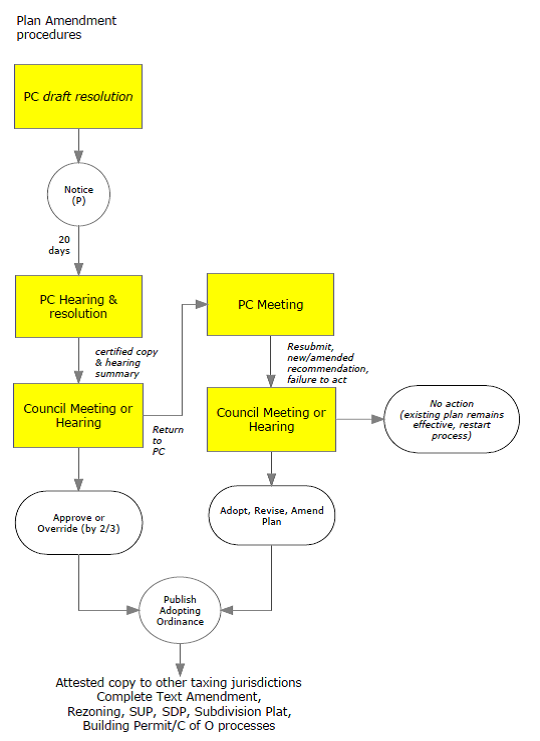18.40.075 Plan Amendments
Purpose: this section describes how the City makes changes to the Comprehensive Plan ( PlanOlathe ). For example, an applicant may use these procedures to ask the City to change the future land use category designated in the Future Land Use Map for a specific property. The procedures in this section are largely required by Kansas law (⇔ reference: K.S.A. 12-747).
A. Applicability
This section applies to the adoption or amendment of the Comprehensive Plan. For purposes of this section, the term “plan” refers to an original comprehensive plan or an amendment to the plan.
B. Initiation
1. The Planning Commission may prepare a resolution to adopt or amend the plan, including any surveys or studies required by state law. A neighborhood meeting is not required.
2. A property owner may, in writing, submit a request to the Planning Commission to adopt or amend the plan along with any necessary surveys, studies, and draft plan policies. The Planning Commission and Governing Body may, in their discretion, consider those policies.
3. A property owner may also submit a plan or plan amendment (subject to subsection 2 above) along with an application for rezoning. The Planning Commission and Governing Body may, in their discretion, consider the rezoning application concurrent with the plan. However, the rezoning does not become effective unless the procedures required by Section 18.40.090 and state law are followed.
4. If the plan amendment involves a specific development proposal, a neighborhood meeting is required (see Section 18.40.030).
C. Completeness Review
Not applicable.
D. Decision
1. Notice by publication is required (see Section 18.40.050.A) for the Planning Commission hearing.
2. The Planning Commission shall conduct a public hearing. At the hearing, the Planning Commission may adopt the plan by resolution. A majority vote is required. If the resolution is adopted, the Planning Commission shall submit a certified copy of the plan and a summary of the hearing to the Governing Body.
3. The Governing Body may consider the plan at a regular meeting or a public hearing. No separate notice is required. The Governing Body may:
a. Approve the Planning Commission recommendations;
b. Override the planning commission's recommendations by a 2/3 majority vote; or
c. Return the plan to the planning commission for further consideration, together with a statement specifying the basis for the governing body's failure to approve or disapprove.
4. If the governing body returns the planning commission's recommendations, the planning commission shall consider them at its next regular meeting and may:
a. resubmit its original recommendations giving its reasons for them, or
b. submit new and amended recommendations, or
c. take no action at the meeting.
5. When the Governing Body receives the Planning Commission’s recommendations or if the Planning Commission fails to take action, the governing body, by a simple majority, may:
a. adopt the plan, or

b. revise and adopt the plan, or
c. amend and adopt the plan.
6. The Governing Body approves a plan by ordinance.
7. The Planning Official shall send an attested copy of the plan to all other taxing subdivisions in the planning area which request a copy of the plan.
E. Subsequent Applications
There is no limit on reapplication for a plan amendment.
F. Scope of Approval
1. The plan is the basis or guide for public action to insure a coordinated and harmonious development or redevelopment which will best promote the health, safety, morals, order, convenience, prosperity and general welfare as well as wise and efficient expenditure of public funds.
2. A plan amendment does not authorize development. Any development that occurs after the plan amendment is adopted is subject to all applicable requirements of this title.
G. Publication
The plan becomes effective after the adopting ordinance is published.